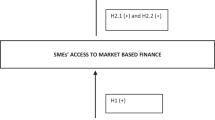Abstract
To shed some light on market delineation in an antitrust context, many economists are turning to estimates of residual demand elasticities. Recent papers have drawn attention to the importance of demand curve in market delineation and explained how they can be estimated. This paper shows that there are many complications and limitations of the approach. The relationship between the residual demand elasticity and the scope of the relevant market is complicated and depends on behavioral assumptions. The residual demand elasticity that can be estimated is not the one on which market delineation turns. The estimation of residual demand elasticities can be very difficult because of the complex dynamics of consumer behavior. Finally, residual demand estimators are likely to have a high variance because of instrument problems and this is likely to lead to widely varying estimates depending on specification choices.
Similar content being viewed by others
References
Baker, Jonathan B. (1987), ‘Why Price Correlations Do Not Define Antitrust Markets: On Econometric Algorithms for Market Definition,’ Working Paper No. 149, Bureau of Economics, Federal Trade Commission, January 1987.
Baker, Jonathan B. and Bresnahan, Timothy F. (1984), ‘Estimating the Elasticity of Demand Facing a Single Firm: Evidence on Three Brewing Firms,’ Research Paper No. 54, Stanford Univ. Department of Economics, 1984.
Baker, Jonathan B. and Bresnahan, Timothy F. (1985), ‘The Gains from Merger or Collusion in Product-Differentiated Industries, Journal of Industrial Economics 33, 427–44.
Baker, Jonathan B. and Bresnahan, Timiothy F. (1988), ‘Estimating the Demand Curve Facing a Single Firm’, International Journal of Industrial Economics 6, 283–300.
Froeb, Luke M. and Werden, Gregory J. (1990), ‘Residual Demand Estimation for Market Delineation: The Cellophane Fallacy Revisited,’ unpublished.
Judge, George, C., Griffith, W. E., Hill, R. Carter, Lütkepohl, Helmut, and Lee Tsoung-Chao (1985), The Theory and Practice of Econometrics (2nd ed.).
Ordover, Janusz A. and Wall, Daniel W. (1989) ‘Understanding Econometric Methods of Market Definition,’ Antitrust 3, 20–25.
Scheffman, David T. and Spiller, Pablo T. (1987), ‘Geographic Market Definition under the U.S. Department of Justice Merger Guidelines’, Journal of Law and Economics 30, 123–47.
U.S. Department of Justice (1984), Merger Guidelines (June 14).
Werden, Gregory J. (1983), ‘Market Delineation and the Justice Department's Merger Guidelines,’ Duke Law Journal 514–79.
Werden, Gregory J. (1985), ‘Is There a Principle for Defining Industries? Comment, Southern Economic Journal 52, 532–36.
Zwangiger, Jack (1989), ‘A Dangerous Concentration in Hospital Markets,’ Wall Street Journal June 19, p. A10.
Author information
Authors and Affiliations
Additional information
Economists, Antitrust Division, U.S. Department of Justice. The views expressed herein are not purported to represent those of the U.S. Department of Justice. We thank Jonathan Baker, Dennis Carlton, Michael Vita, and participants in seminars at the Federal Trade Commission, Department of Justice, and meetings of the Western Economic Association for helpful comments.
Rights and permissions
About this article
Cite this article
Froeb, L.M., Werden, G.J. Residual demand estimation for market delineation: Complications and limitations. Rev Ind Organ 6, 33–48 (1991). https://doi.org/10.1007/BF00427999
Issue Date:
DOI: https://doi.org/10.1007/BF00427999




